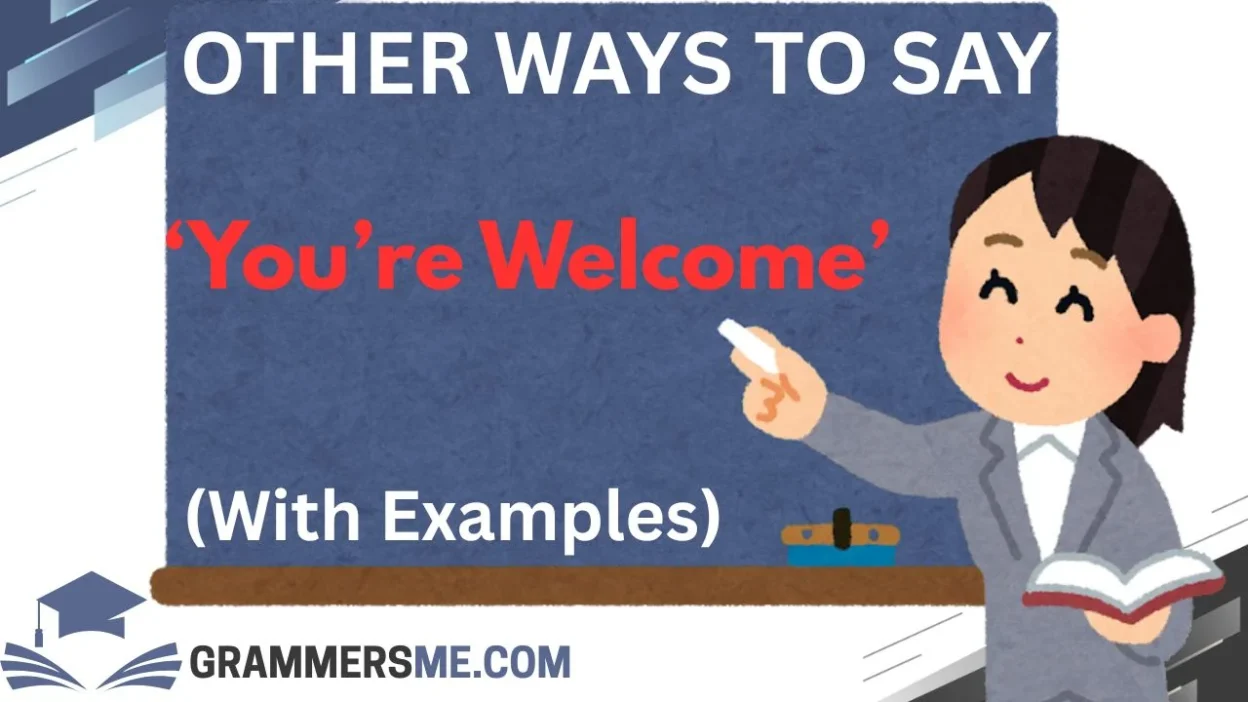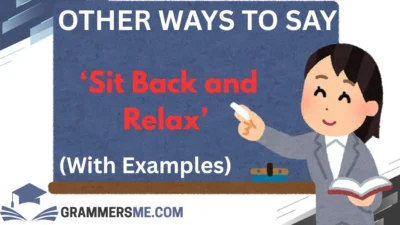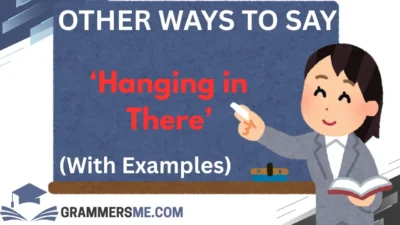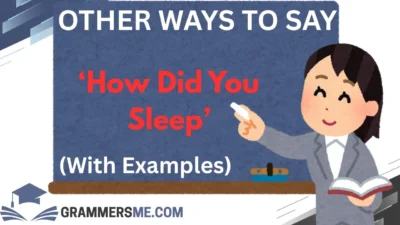In a world where connection matters more than ever, the way we respond to a simple “thank you” can hold surprising weight. Saying “you’re welcome” is polite, sure—but sometimes, we want our words to carry more heart.
Whether it’s a friend, colleague, or even a stranger, finding thoughtful, warm ways to respond can make your communication more genuine and memorable. Below, you’ll find 30 heartfelt alternatives to “you’re welcome,” complete with real-life examples, so you’re ready to respond with care in any situation.
What Does “You’re Welcome” Mean?
Meaning: “You’re welcome” is a polite response to someone thanking you. It acknowledges their gratitude and lets them know you’re happy to help.
Explanation: It’s a courteous phrase that signals kindness and humility. But sometimes, it may come off as automatic or even impersonal—especially when used repeatedly in casual, emotional, or professional settings.
Tone: Neutral to polite. Can be friendly, but often feels more formal than warm.
Is It Professional/Polite to Say “You’re Welcome”?
Yes, saying “you’re welcome” is both professional and polite. It’s widely accepted in business and casual settings alike. However, in more empathetic or personal moments, choosing a phrase with a bit more emotional weight can make your message more impactful.
1. Anytime
Meaning: You’re always happy to help.
Explanation: “Anytime” suggests openness and availability, showing the other person they can count on you.
Example: “Thanks for picking me up!” “Anytime.“
Best Use: In casual or friendly conversations.
Not Use: In very formal emails or professional contexts.
Tone: Warm, relaxed, supportive.
2. Of course
Meaning: Helping them was a given.
Explanation: This phrase implies that your help was natural and unquestioned, which can feel reassuring to the listener.
Example: “Thanks for helping with the report.” “Of course. I’m glad I could assist.”
Best Use: Casual to semi-professional situations.
Not Use: When the help was difficult or inconvenient—it can sound dismissive.
Tone: Reassuring, kind.
3. It was my pleasure
Meaning: You genuinely enjoyed helping.
Explanation: A classic and courteous way to respond, often used in service settings but also fitting for heartfelt moments.
Example: “Thank you for being there last night.” “It was my pleasure.“
Best Use: Formal, sincere, or customer service settings.
Not Use: If the task truly was a burden—it may seem disingenuous.
Tone: Gracious, elegant.
4. No problem at all
Meaning: It wasn’t a big deal for you.
Explanation: A relaxed and friendly phrase that emphasizes your willingness to help without any trouble.
Example: “Thanks for grabbing coffee.” “No problem at all!“
Best Use: Informal or friendly exchanges.
Not Use: When professionalism or formality is required.
Tone: Casual, chill.
5. Not a problem
Meaning: Same as above, just a shorter version.
Explanation: Popular in North American English, it helps lighten the interaction.
Example: “Thanks again for the advice.” “Not a problem.“
Best Use: Everyday conversations with peers.
Not Use: In very formal or international settings—some cultures prefer direct acknowledgments.
Tone: Friendly, informal.
6. Don’t mention it
Meaning: It was nothing worth fussing over.
Explanation: This phrase has a slightly old-school charm and communicates that you were happy to help.
Example: “Thanks for helping me move.” “Don’t mention it.“
Best Use: Warm but reserved contexts—especially with acquaintances.
Not Use: With people who might feel dismissed by understatement.
Tone: Humble, understated.
7. My pleasure
Meaning: You were truly happy to help.
Explanation: It feels both elegant and heartfelt, and is commonly used in both customer service and personal exchanges.
Example: “Thanks for the invite!” “My pleasure!“
Best Use: Formal or heartfelt replies.
Not Use: In very casual chats—it might feel too polished.
Tone: Refined, caring.
8. Sure thing
Meaning: Absolutely, no problem.
Explanation: Colloquial and breezy, it carries a sense of confidence and ease.
Example: “Thanks for covering my shift.” “Sure thing!“
Best Use: Informal settings.
Not Use: Formal or written communication.
Tone: Upbeat, friendly.
9. Glad to help
Meaning: You were happy to be useful.
Explanation: This one feels sincere without being overly formal.
Example: “Thanks for your feedback!” “Glad to help.“
Best Use: Friendly or semi-professional interactions.
Not Use: In highly emotional moments—it might feel too transactional.
Tone: Helpful, kind.
10. You got it
Meaning: Absolutely, I’m on it.
Explanation: Shows confidence and friendliness—great for quick exchanges.
Example: “Thanks again!” “You got it.“
Best Use: Informal chats or casual work messages.
Not Use: Formal business settings.
Tone: Energetic, supportive.
11. No worries
Meaning: There’s no reason to stress—it was fine.
Explanation: This easygoing phrase is popular in Australian and British English, and it’s a great way to downplay any inconvenience.
Example: “Thanks for waiting for me!” “No worries!“
Best Use: Casual, low-stakes situations.
Not Use: In professional emails or serious conversations.
Tone: Relaxed, friendly.
12. Happy to help
Meaning: You were genuinely pleased to assist.
Explanation: This phrase is reassuring and heartfelt, making it ideal for both personal and light professional use.
Example: “Thanks for the notes!” “Happy to help.“
Best Use: Any time you want to show warmth and willingness.
Not Use: When the help was forced or inconvenient.
Tone: Kind, supportive.
13. It’s nothing
Meaning: What you did wasn’t a big deal to you.
Explanation: This phrase is a way to show humility and reassure the other person not to feel indebted.
Example: “Thank you for letting me borrow your car!” “It’s nothing.“
Best Use: Personal interactions with close friends or family.
Not Use: If it actually was a big effort—you risk sounding dismissive.
Tone: Humble, casual.
14. No big deal
Meaning: The favor or action wasn’t difficult or bothersome.
Explanation: A casual phrase that takes the pressure off someone’s gratitude.
Example: “Thanks so much for your time.” “No big deal.“
Best Use: Informal conversations, especially among peers.
Not Use: Formal situations—it can sound too dismissive.
Tone: Relaxed, modest.
15. It was the least I could do
Meaning: You’re saying you wish you could’ve done even more.
Explanation: This humble response carries a touch of compassion and makes your act of kindness feel deeply intentional.
Example: “Thanks for everything you’ve done.” “It was the least I could do.“
Best Use: Sincere moments with emotional weight.
Not Use: Everyday minor favors—it may feel dramatic.
Tone: Heartfelt, gracious.
16. Absolutely
Meaning: Yes, definitely—you were glad to help.
Explanation: Simple but enthusiastic, this is a great one-word reply that affirms your positivity.
Example: “Thanks again!” “Absolutely.“
Best Use: Quick, friendly replies.
Not Use: If more explanation is expected—it’s a bit too short for deeper contexts.
Tone: Affirming, bright.
17. It’s all good
Meaning: Everything’s fine—no stress at all.
Explanation: This laid-back phrase reassures the other person that everything’s cool.
Example: “Thanks for fixing that mix-up!” “It’s all good.“
Best Use: Informal chats with friends, coworkers.
Not Use: Formal settings or where clarity is important.
Tone: Chill, casual.
18. That’s what friends are for
Meaning: Helping is just part of being a friend.
Explanation: This phrase adds a personal and loyal touch to your response.
Example: “Thanks for covering for me.” “That’s what friends are for.“
Best Use: Close friendships or emotionally supportive moments.
Not Use: Professional or casual acquaintances.
Tone: Affectionate, caring.
19. I’ve got your back
Meaning: You’re there for them—now and always.
Explanation: This shows strong support, trust, and friendship.
Example: “Thanks for sticking up for me.” “I’ve got your back.“
Best Use: Close relationships or loyal friendships.
Not Use: In work emails or with authority figures.
Tone: Supportive, protective.
20. That’s what I’m here for
Meaning: Helping is part of your role or relationship.
Explanation: This one is great for situations where you’re offering support as a mentor, leader, or friend.
Example: “Thank you for walking me through everything.” “That’s what I’m here for.“
Best Use: Mentorship, teamwork, or leadership contexts.
Not Use: When you’re not in a clear role of support—it may feel forced.
Tone: Empowering, warm.
21. Always happy to
Meaning: You’re always ready to help again.
Explanation: It’s a warm and future-oriented phrase that keeps the door open for future collaboration or support.
Example: “Thanks for answering all my questions.” “Always happy to.“
Best Use: Professional and personal replies.
Not Use: If you’re not genuinely willing to help again.
Tone: Encouraging, approachable.
22. It was nothing at all
Meaning: You want them to feel zero burden.
Explanation: A slightly more expressive way of saying “no big deal,” with a gentle and polite tone.
Example: “Thanks for picking that up!” “It was nothing at all.“
Best Use: Gracious replies in social or light business settings.
Not Use: If the help was truly a big effort.
Tone: Kind, polite.
23. You would’ve done the same
Meaning: You believe they’d return the favor.
Explanation: This builds mutual respect and camaraderie, making it great for close relationships.
Example: “Thanks for staying so late!” “You would’ve done the same.“
Best Use: Friends, colleagues you trust.
Not Use: Strangers or new acquaintances.
Tone: Equal, respectful.
24. Always a pleasure
Meaning: Helping them brings you joy.
Explanation: It’s polished yet personal—great when you want to maintain professional warmth.
Example: “Thank you for your insights.” “Always a pleasure.“
Best Use: Emails, meetings, service interactions.
Not Use: Super casual or ironic situations.
Tone: Gracious, refined.
25. With pleasure
Meaning: You did it happily.
Explanation: This is a slightly formal yet very charming way to respond, often used in European English.
Example: “Thanks for the update.” “With pleasure.“
Best Use: Polished personal or client-facing interactions.
Not Use: Too informal or sarcastic scenarios.
Tone: Polite, classy.
26. Sure!
Meaning: A quick and easy yes.
Explanation: Super simple, but can be very genuine when said with the right tone.
Example: “Thanks so much!” “Sure! Anytime.”
Best Use: Text messages, everyday interactions.
Not Use: Professional emails—it may come off as curt.
Tone: Friendly, brief.
27. I’m here for you
Meaning: You’re emotionally available to support.
Explanation: This one adds a deeper, caring layer to your response, especially in sensitive moments.
Example: “Thanks for listening.” “I’m here for you.“
Best Use: Emotional conversations with friends, loved ones.
Not Use: Surface-level interactions or light-hearted moments.
Tone: Compassionate, heartfelt.
28. Always
Meaning: You’re consistently there for them.
Explanation: One word that communicates loyalty and warmth, especially when used after a sincere “thank you.”
Example: “Thanks for everything.” “Always.“
Best Use: Close bonds and loyal friendships.
Not Use: Formal business replies—it may feel vague.
Tone: Warm, emotionally rich.
29. It’s what I do
Meaning: Helping is part of who you are.
Explanation: This lighthearted response can show confidence while staying friendly.
Example: “Thanks for the fix!” “It’s what I do.“
Best Use: When you’re known for helping or solving problems.
Not Use: In serious, emotional situations—it might sound flippant.
Tone: Confident, playful.
30. No thanks needed
Meaning: You don’t expect or require thanks.
Explanation: This phrase communicates true selflessness, ideal when you want to shift focus away from yourself.
Example: “Thanks for everything you’ve done.” “No thanks needed. I was happy to do it.”
Best Use: Deeply kind responses, especially in meaningful moments.
Not Use: In customer service or where thanks are expected.
Tone: Humble, heartfelt.
Conclusion:
Finding the right way to say “you’re welcome” isn’t just about etiquette—it’s about empathy. Whether you’re responding to a heartfelt thank you or just a casual nod of appreciation, the words you choose can deepen connections, show sincerity, and leave people feeling truly seen. Over the years, I’ve found that even the smallest verbal shifts—saying “Happy to help” instead of “You’re welcome”—can soften a conversation, warm a relationship, and foster trust.
Words matter. And when we choose them thoughtfully, they become more than replies—they become bridges between people.
FAQs
1. Is it rude to not say “you’re welcome”?
Not at all—as long as you respond in a kind, thoughtful way. Phrases like “Anytime” or “Happy to help” can feel even warmer.
2. What’s the most professional alternative to “you’re welcome”?
“My pleasure” and “Always happy to help” work beautifully in professional or formal settings.
3. Can I say “no problem” at work?
Yes, in many workplaces it’s acceptable—but some cultures prefer more direct acknowledgments like “Glad to help.”
4. What if I don’t feel like saying anything?
If you’re feeling overwhelmed or tired, even a smile or simple “Of course” can go a long way without overextending yourself.
5. Is “you’re welcome” outdated?
Not outdated—but it’s sometimes overused. Mixing in thoughtful alternatives can make your communication more authentic and personal.




